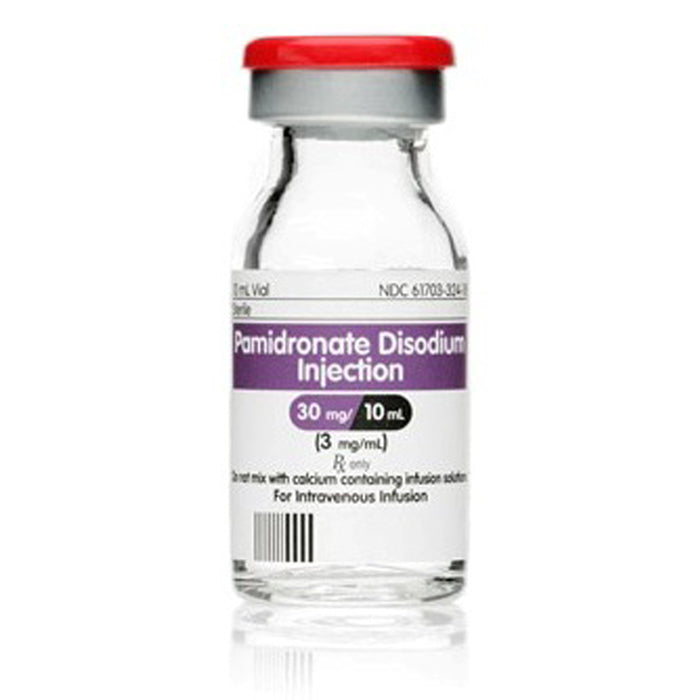Pamidronate Disodium Injection 3 mg/mL Single Dose Vial 10 mL
How to Order:
You will receive instructions on how to create an account along with Rx Ordering Details.
(Note: Acceptable licenses must have Prescriptive Authority in the license issuing state.)
Pamidronate Disodium Injection is used primarily to treat hypercalcemia associated with malignancy, as well as to manage bone pain related to certain cancers such as multiple myeloma and metastatic breast cancer. It works as a bisphosphonate by inhibiting bone resorption, thereby reducing elevated blood calcium levels and bone pain. Additionally, it is used in the treatment of Paget's disease of bone. Administered intravenously, Pamidronate Disodium requires monitoring for renal function and other side effects by healthcare professionals.
Pfizer Injectables introduces Pamidronate Disodium Injection, an effective bisphosphonate therapy formulated at a concentration of 3 mg/mL, presented in a convenient 10 mL single-dose vial. Designed for intravenous administration, this medication is highly beneficial in managing conditions associated with high bone turnover such as hypercalcemia of malignancy, Paget’s disease of bone, and osteolytic bone lesions in multiple myeloma and breast cancer patients. Produced with Pfizer’s commitment to quality and safety, this injectable solution provides a robust option for healthcare professionals seeking reliable and targeted bone health management.
Product Details and Features:
Active Ingredient: Each 10 mL single-dose vial contains 3 mg/mL of pamidronate disodium, a potent bisphosphonate compound aimed at regulating bone resorption.
Medical Indications: Primarily indicated for the treatment of hypercalcemia associated with malignancy (HCM), Paget’s disease, and osteolytic bone metastases of breast cancer and multiple myeloma.
Packaging: Provided in sterilized vials meant for single-use injection, ensuring ease of access and reliability during administration.
Dosage Form: Designed for intravenous infusion, allowing precise delivery of the medication to the targeted area of effect.
Pfizer Assurance: As a product of Pfizer, this injection meets high quality and ethical standards, incorporating advanced pharmaceutical technology into clinical therapy.
Mechanism of Action:
Pamidronate disodium acts by adhering to hydroxyapatite binding sites on bony surfaces, especially those undergoing active resorption. Through the inhibition of osteoclast activity (the cells responsible for bone degradation), pamidronate decreases bone turnover. This mechanism curtails the release of calcium from bones into the bloodstream, thereby managing elevated calcium levels due to cancer. Additionally, in conditions like Paget’s disease, it normalizes bone metabolism by reducing abnormal bone resorption and improving bone mineral density.
Warnings:
-
Renal Impairment: Monitor renal function during treatment, as pamidronate can cause renal toxicity, particularly with high doses and rapid infusion rates.
-
Hydration: Ensure patients are well hydrated before administration to minimize renal adverse effects.
-
Hypocalcemia: Use with caution in patients with pre-existing hypocalcemia. Such conditions should be corrected before commencing therapy.
-
Pregnancy Category D: Pamidronate is not recommended for use during pregnancy due to the potential for fetal harm.
Side Effects:
Common side effects may include:
- Fever
- Fatigue
- Nausea and vomiting
- Bone pain
Serious side effects that demand immediate medical attention include:
- Symptoms of renal dysfunction (e.g., unexpected weight gain or swelling)
- Severe skin reactions, which could signify allergies
- Jaw pain and swelling, potentially related to osteonecrosis of the jaw
- Electrolyte imbalances beyond hypocalcemia, including magnesium and potassium deviations
Conclusion:
Pamidronate Disodium Injection 3 mg/mL by Pfizer Injectables offers a comprehensive approach to managing conditions caused by rapid bone turnover and calcium metabolism imbalances. With its proven efficacy and safety profile upheld by Pfizer’s high manufacturing standards, healthcare professionals can apply this therapy confidently to improve patient outcomes in those with malignancy-related calcium disorders and other bone-related illnesses. Always consult with a healthcare professional to tailor the therapy to individual patient needs and conditions.


